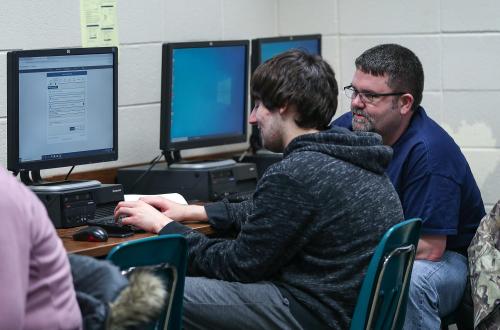The U.S. Department of Education (ED) recently announced that the 2024-25 redesign of the Free Application for Federal Student Aid (FAFSA) will be released in December—a departure from the traditional October 1 release of the form. ED attributes the delay of the launch date to the unprecedented complexity of the changes, which are intended to simplify the process of applying for federal aid for college.
Each year, high school seniors fill out a FAFSA to determine their eligibility for student financial aid to pay for college. However, not all students do, and those most likely to benefit from federal aid are also less likely to apply for it—in 2016, 63% of college-intending high schoolers in the lowest-income quintile completed a FAFSA, compared to 73% of those in the highest-income quintile. Studies show that complications in the FAFSA filing process, as well as lack of awareness about financial aid options and the overall cost of college, can pose significant barriers to college application and attendance, particularly for low-income students.
Continuing to improve college access, particularly for low-income students, begins with understanding the barriers students face in filling out the FAFSA and acquiring financial aid. This post outlines these barriers and makes recommendations to alleviate them.
Complexity of financial aid processes pose challenges for applicants
The FAFSA has historically been a very difficult form to navigate. The process can be especially challenging for low-income students, who tend to have fewer academic supports and whose parents are less likely to have been through the college application process. Financial challenges and anxieties associated with poverty can further strain families’ ability to navigate complex processes.
Even once the form is completed and submitted, students can be selected for income and asset verification. Low-income applicants are selected for verification at disproportionate rates. A study of financial aid applicants in Iowa estimated that 57% of students eligible for Pell Grant funds had to verify their forms, while only 7% of non-Pell-eligible students did. The income verification process differs for each institution and can delay FAFSA filers from receiving award packages. The delay in processing affects not only students’ receipt of federal grants, which primarily target the lowest-income applicants, but also applications for state and institutional aid—which often have higher income eligibility thresholds. Students frequently report that issues with FAFSA completion and verification prevent them from enrolling in courses or lead them to be dropped from courses due to nonpayment. Moreover, 11% of students selected for verification (and some experts believe this number is much higher) drop out of the process altogether, compromising their ability to pay for and complete college.
Misinformation about aid eligibility a significant barrier to low-income applicants
Complexities of the application process are compounded by lack of awareness of financial aid options and the total cost of college. Low-income students may have higher learning costs of acquiring information about available financial aid. They also face greater ambiguity about costs of college. Several prior studies show significant increases in college application and enrollment when low-income students receive messaging campaigns informing—and guaranteeing—them free tuition they were already eligible for. These students would have already been eligible for this aid, suggesting that insufficient awareness depresses college enrollment among this group.
To investigate these barriers, we analyzed HSLS-09, a nationally representative sample of 2009-10 ninth graders followed through their secondary and postsecondary years. We focused our analysis on students intending to complete a bachelor’s degree. The survey shows that low-income students are particularly underinformed and under-supported with respect to financial aid and the FAFSA process. About 22% of college-intending students in the lowest-income quintile who didn’t complete the FAFSA reported they “did not know [they] could complete one,” compared to 6.8% of students in the highest-income quintile. And 35.2% of lower-income students did not complete the FAFSA because they “did not know how,” compared to 10.6% in the upper quintile.
In some cases, these students (and again, more frequently, lower-income students) were actually misinformed. About a third of students who didn’t file the FAFSA thought they were ineligible. Among those students, 38.5% in the lowest-income quintile thought they were unqualified for FAFSA because their “academics [were] too low,” compared to 9.1% of highest-income students (despite there being no academic performance threshold for incoming students to apply for federal aid). Low-income students were also more likely to think they were unqualified if they attended college part-time, and because of credit scores (neither of which fully disqualifies students from aid). In contrast, almost all high-income students who didn’t file assumed their income was too high.
Research-supported approaches to alleviate existing barriers
There are several research-based methods that reduce the burden on low-income students interested in college and encourage financial aid application completion. These interventions should be scaled for greater impact.
- FAFSA Sundays, FAFSA drives, and FAFSA mandates
College access advocates and organizations have taken it upon themselves to reduce the learning costs that may prevent students from applying for financial aid, creating FAFSA Sundays and FAFSA drives to offer free and accessible assistance to students and families. Counselors and state officials report that these supports have been successful at increasing FAFSA completion rates. These efforts draw on insights from an experiment that found providing 1:1 assistance to high school seniors increased FAFSA submission rates by 16 percentage points, as well as the likelihood of college attendance, persistence, and financial aid receipt.
Several states have adopted FAFSA mandates that require students to complete the form for graduation and provide additional support to help them through the process. In Texas, FAFSA completion rates jumped from 50% to 63% following the adoption of a mandate, and Louisiana high school FAFSA completion rates increased by 19 percentage points (to 72%) in the post-mandate period. Research indicates that mandates can also boost college enrollment. A caveat is that the mandates require additional support from counselors or college access advisors to assist students with the process, which is challenging when these staff are already spread thin.
- Mailings and outreach
A simple way to reduce the information gap is to increase outreach efforts to low-income students. Personalized messages have shown success at increasing enrollment across multiple program contexts. A Michigan study of high-achieving, low-income high school students who received personalized mailings with information about free tuition they were eligible for showed significant increases in application and enrollment.
Text message interventions have been successful at increasing financial aid filing. These interventions are low cost and highly scalable: for example, a Texas FAFSA filing campaign reached approximately 7,500 high school seniors at a cost of $8 per student reached. They can also more effectively reach the target audience, as mail tends to be overlooked by young people and can get lost. However, this strategy has had mixed results when implemented at scale, and a personal connection may be essential to the effectiveness of text-based nudges.
- Relax income verification to the rate of federal tax returns
ED selects about 35% of FAFSA filers for verification, compared to less than 2% of federal tax returns selected for audit. In 2021, during the height of the COVID-19 pandemic, ED relaxed income verifications to 18%. ED is making efforts to continue these reductions: the 2022 FAFSA Simplification Act directs that they “streamline and simplify the process of verification for applicants,” and part of the 2024-25 FAFSA process redesign will make it easier for the Office of Federal Student Aid ( FSA) and the IRS to share taxpayer data, reducing the need for income verification.
Verification deters student enrollment and costs colleges nearly $500 million annually—a burden which falls heavily on community colleges with fewer resources. Evidence suggests that the audits do not significantly change financial eligibility for those who complete verification. If this is the case, why not dramatically decrease the number of filers selected for verification? Impediments to student enrollment with little proven benefit should be reduced.
The FAFSA Simplification Act will make the process of applying for aid easier in the long run, but it will be a difficult transition for students and families. The FSA has coordinated an outreach campaign to provide resources for students, families, schools, states, and college-access professionals regarding the changes. This is helpful, but the changes will require sustained proactive work to communicate with students and families and to avoid confusion. They will also require additional state and university investment in support systems to navigate the new process. States might consider changing their priority application deadlines, as the delayed release will give students little time to apply. Continued communication and transparency will give stakeholders time to prepare and adapt their processes.
Financial aid access and transparency is not a cure-all to increasing equity in college enrollment—but it is a necessary first condition. We should be removing as many barriers as possible to ensure all can attain a postsecondary credential that is essential to success in the modern workforce.









Commentary
Improving college access through financial aid transparency and FAFSA simplification
May 4, 2023
Continuing to improve college access, particularly for low-income students, begins with understanding the barriers students face in filling out the FAFSA and acquiring financial aid.